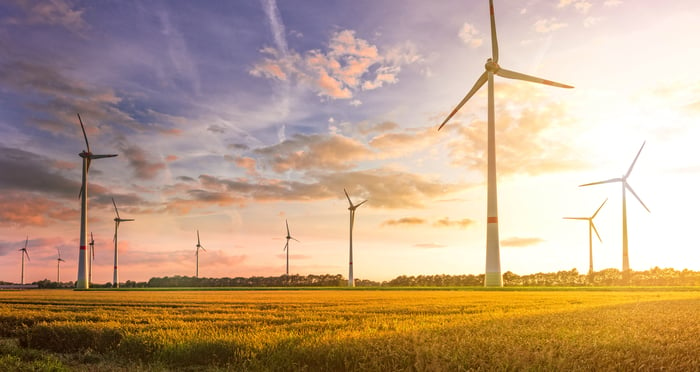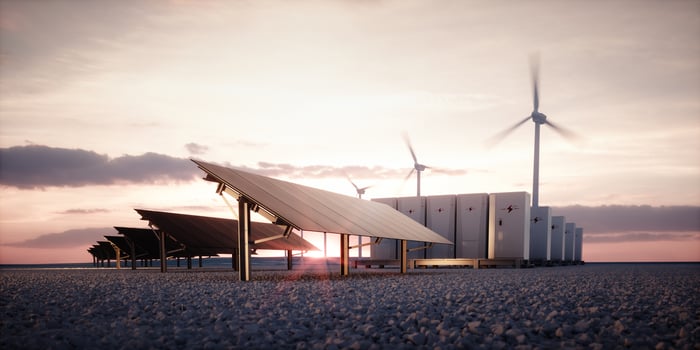One of the biggest criticisms of renewable energy is that it doesn't provide steady power, since the sun isn't always shining and the wind doesn't always blow. This intermittency issue forces utilities to rely on fossil fuels like coal and natural gas to fill in the gaps.
NextEra Energy (NEE 1.36%), however, is working on innovative solutions to overcome this problem. CFO Rebecca Kujawa ran through a few of them on the utility's first-quarter conference call.

Image source: Getty Images.
Intermittency on display
Traditional power plants fueled by coal, natural gas, and nuclear generate very steady electricity. That's not the case with renewables, which have much more variability in the power they produce. That was quite evident in NextEra Energy's first-quarter results. While the utility delivered strong results as earnings per share jumped 12% year over year to $2.20 a share, the company experienced a notable headwind during the quarter that negatively affected results.
Kujawa pointed out that adjusted earnings in its energy resources segment increased $0.10 per share from the prior-year period. The company benefited from new investments, good performance in its natural gas infrastructure business, and some other factors, which added $0.20 per share to the total. Offsetting half of those gains, however, were some headwinds in its legacy generating business, mainly because of a weaker wind resource during the period.
"First quarter fleetwide wind resource was one of the worst over the past 30 years, at 91% of the long-term average, versus 102% during the first quarter of 2018," Kujawa said. "We continue to have confidence in the accuracy of our long-term wind resource assumptions and expect to continue to experience both positive and negative quarterly variability."
In other words, the wind, which was stronger than usual in the year-ago period, was well below average during this year's first quarter. So the company didn't generate as much power from its wind assets in the period, which affected earnings.

Image source: Getty Images.
Creative solutions to the problem
Problems like that are a common occurrence in the renewable-energy sector. That's why many utilities often build natural gas-fired plants to complement renewables so that they can offset periods when renewable resources are weaker.
NextEra, however, is working on alternatives to fossil-fuel backup power. For example, its Florida Power & Light (FPL) utility is building a large-scale battery storage system to replace aging and costly gas plants. Kujawa discussed this project:
During the quarter, FPL also announced its modernization plan to replace two existing natural gas steam units, totaling approximately 1,650 megawatts, with clean and renewable energy, including the world's largest solar-powered battery system. The 409-megawatt, 900-megawatt-hour Manatee Energy Storage Center is expected to increase the predictability of the existing co-located solar project, enabling FPL to more efficiently dispatch other power plants. The project is expected to be in service in 2021 and save customers more than $100 million, while eliminating more than 1 million tons of carbon dioxide emissions.
In this project, the company is building a large-scale battery system that it will charge from an existing solar power plant. That will allow the company to discharge power from the batteries when the sun isn't shining, enabling it to produce more consistent electricity. This facility will save customers lots of money in the long run, since it will offset the more expensive power produced at the aging gas plants.
The company is also taking a unique approach to a new project in Oregon. It's teaming up with utility Portland General Electric to build the Wheatridge Renewable Energy Facility that will combine 300 MW of wind, 50 MW of solar, and 30 MW of battery storage. It's the first ever project that co-locates wind, solar, and storage. By combining all three technologies, the companies should be able to provide the grid with reliable power.
Kujawa stated on the call that NextEra is working to "further advance the next phase of renewables deployment that pairs low-cost wind and solar energy with a low-cost battery storage solution to provide a product that can be dispatched with enough certainty to meet customer needs for a nearly firm generation resource." In order words, the company aims to replace the need for fossil fuel plants to provide predictable power by co-locating renewable technologies with storage capacity. The trend will become even more common as the cost of energy storage continues declining in the coming years. In the company's view, solar and wind will soon become cheaper than all but the most efficient natural gas plants within the next decade, even after adding in a supplemental energy storage system.
A bright future for renewables
Companies like NextEra Energy are working to solve the problems holding back even greater adoption of renewables. It's strategically adding backup storage to replace high-cost fossil fuel plants by co-locating technologies to smooth out power production. These initiatives could help speed up the adoption of renewables, which could enable NextEra to grow at an accelerated rate in the future.





